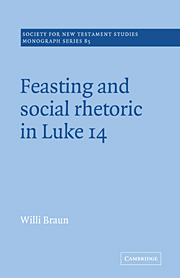Book contents
- Frontmatter
- Contents
- Acknowledgements and note on abbreviations
- 1 Introduction: how to read Luke 14?
- 2 Assumptions and preliminary reading
- 3 Jesus as a healer of craving desire (14.1–6)
- 4 Uncommon ‘symposium rules’ (14.7–11, 12–14)
- 5 The big dinner (14.15–24): aspects of Lukan performance
- 6 The conversion of a wealthy householder
- 7 Forms, genres and composition
- 8 Composition as argumentation: the rhetoric of Luke 14
- 9 Towards closure (and openings)
- Bibliography
- Indices
8 - Composition as argumentation: the rhetoric of Luke 14
Published online by Cambridge University Press: 28 August 2009
- Frontmatter
- Contents
- Acknowledgements and note on abbreviations
- 1 Introduction: how to read Luke 14?
- 2 Assumptions and preliminary reading
- 3 Jesus as a healer of craving desire (14.1–6)
- 4 Uncommon ‘symposium rules’ (14.7–11, 12–14)
- 5 The big dinner (14.15–24): aspects of Lukan performance
- 6 The conversion of a wealthy householder
- 7 Forms, genres and composition
- 8 Composition as argumentation: the rhetoric of Luke 14
- 9 Towards closure (and openings)
- Bibliography
- Indices
Summary
I have pointed out that the dinner episode begins with a unit that falls within the definitional boundaries of a chreia and that the remaining parts are of the kind which ancient instructors in the rhetorical arts considered to be essential in constructing a chreia-based argument. Before pursuing the intuition that where there is a chreia followed by analogies there is probably an argument waiting to be analysed, it is worth noting that the intuition itself has the support of a scholarly tradition, though one neglected until very recently.
Chreiai, parables and arguments
In the second edition (1933) of his Formgeschichte des Evangeliums Martin Dibelius introduced a discussion of the Hellenistic chreiai and noted their similarity to the gospel units he called ‘paradigms’ (pp. 149–64). In the context of a notice that Luke seems particularly keen on casting traditional material into a ‘chrienartige Fassung’ he also observed that this evangelist tended to frame parables with a ‘Situationsangabe’ reminiscent of the sayings chreiai. Among the six parables he cited as examples is 14.16–24 (p. 161). Dibelius oddly offered this only as a bare observation, but one which nonetheless is suggestive for further study.
- Type
- Chapter
- Information
- Feasting and Social Rhetoric in Luke 14 , pp. 145 - 175Publisher: Cambridge University PressPrint publication year: 1995

